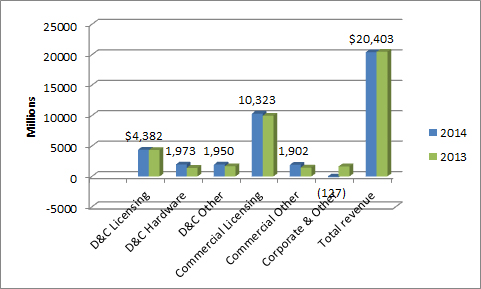News
Microsoft Releases Q3 Earnings Numbers
The financial report shows Windows Azure and Office 365 with significant growth.
Microsoft continues to hold steady in its financial situation.
The company met financial analyst expectations with the release of its third-quarter fiscal-year 2014 earnings report.
The diluted earnings per share figure of $0.68 in the Q3 report actually beat the $0.63 expectation of financial analysts. However, the Q3 revenue of $20.40 billion essentially met analyst expectations of $20.39 billion.
Microsoft's net income for the quarter was $5.66 billion vs. $6.05 billion in the previous Q3 period. The Q3 period ended on March, 31, 2014.
Microsoft provided some aggregate figures for the company's business segments in its Q3 report. It reported overall "Commercial" revenue of $12.23 billion, up 7% year over year. In addition, Microsoft's "Devices and Consumer" revenue was $8.30 billion, up 12%.
The chart below shows Microsoft's six reporting segments, comparing Q3 2014 results (blue) with results from the same period last year (green).
 Microsoft Q3 2014 revenue earnings across segments.
Microsoft Q3 2014 revenue earnings across segments.
Based on the Q3 report, there were deficits on the "Devices and Consumer Licensing" side (which includes Windows OEM, Windows consumer and Office consumer revenue), as well as on the "Devices and Consumer Other" side. Devices and Consumer Other is a grab bag category that including products such as Windows Store and Xbox Live transactions, search and display advertising, and subscriptions to Office 365 Home and Personal editions, as well as games and other consumer products, according to Microsoft's 10-Q description.
The Q3 revenue figures were affected by revenue from past consumer product deals, including a Windows Upgrade Offer, Office Deferral and Xbox Deferral. However the revenue also took a hit from a $733 million (€561 million) payout to the European Commission for failing to include a browser choice screen on Windows PCs sold in Europe.
Microsoft disclosed some highlights for the quarter on the Commercial side:
- Windows volume licensing grew 11%
- Windows Azure growth of 150%
- Double-digit Exchange, Lync and SharePoint growth
- Office 365 revenue growth greater than 100%
On the Consumer side, Windows OEM revenue was up 4%. Surface revenue was $500 million, up 50%. Office 365 Home edition now has 4.4 million subscribers. Bing search in the U.S. market was up 18.6%.
About the Author
Kurt Mackie is senior news producer for 1105 Media's Converge360 group.